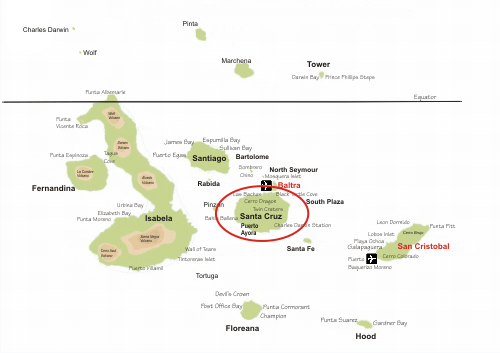

Destinations
Experiences
 |
L A
D A T C O T O U R
S |
 |
||||||||
| HOME | South America | Falkland Islands | Antarctica | Unique Destinations |
Unique Experiences |
Newsstand | ||||
| GALAPAGOS ISLANDS HIGHLIGHTS Map |
 |
SANTA
CRUZ ISLAND
|
| Charles Darwin Research Station Base for the Galapagos National Park offices where scientists, rangers and park managers strive to preserve and protect the islands. The station conducts scientific research and environmental education efforts. The station is also a tortoise breeding and rearing center where different species of tortoises are reared for re-entry into their natural habitats. Here one can see the famous Galapagos Tortoises that give name to the archipelago. |
|
||
| Turtle Cove One of the impressive Galapagos marine sites, Turtle Cove consists of a deep maze of tranquil sea water inlets, surrounded by mangrove thickets of three species. Its waters are still, usually rather murky and are the resting (and sometimes mating) place for marine turtles, rays and small sharks. |
|
||
| Puerto Ayora Village with growing number of shops, boutiques, hotels and restaurants. The main attraction is the Charles Darwin Research Station & tortoise breeding pens. |
|
||
| Bahia Ballena The visitor site of Bahia Ballena (Whale Bay) is a cove of green sand at the base of Dragon Hill on the west coast of Santa Cruz Island. The beach contains a large amount of olivine crystals, the same that originate from volcanic materials. Near the beach there are ceramic relics which reflect the same antiques of human settlements that were close to the beach in 1846. According to the accounts of the French captain Genie, a path originated from this site to the top of the island which was used to collect fresh water. It is thought that here lived a group of people who were dedicated to the collection of lichen used for tinting. Here there existed a small population of tortoises from the island Pinzón, that were probably taken by whalers or ancient inhabitants. |
. |
||
| Twin Craters These two large craters in the middle of the island are, geologically speaking, seen as craters although its formation is not directly due to volcanic action. They were created as a result of the collapse or sinking of surface materials. Although introduced species have taken over some native plants, there are still many Scalesia trees. The woodpecker finch and vermillion flycatcher, an outstanding terrestrial bird, can be seen here. |
|
||
Cerro Dragon |
|
||
Las Bachas Landing
beach and beach continues to the remains of a floating dock abandoned by American soldiers
in World War II. |
|